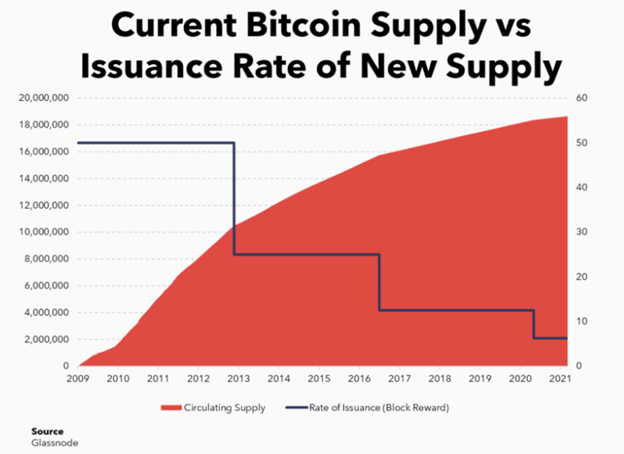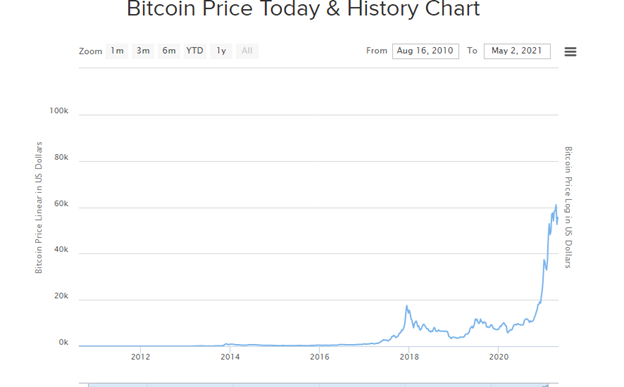Bitcoin Basics and Thoughts on Digital Currency
May 6, 2021. By JD Wolfsberg:
There is no way to miss the attention-grabbing headlines shouting about the price action of the many emerging cryptocurrencies, with the majority tracking the well-known Bitcoin. This particular digital currency has become well known within the financial community, with members having a variety of opinions ranging from confident optimists to doubtful skeptics. The former are typically members of the tech community who are accustomed to being at the forefront of change, while the latter are those who deem the fundamental value of Bitcoin unexplainable. In either case, the digital currency asset class is foreign to most as many investors are learning about this relatively new concept of digital money. We have had numerous client conversations covering the technicalities of Bitcoin but also wanted to share some of the basics:
First Things First: What is Bitcoin?
Bitcoin is form of digital currency that allows peer-to-peer transactions over the internet, foregoing traditional financial intermediaries. Any two parties can send bitcoin directly to each other and it is not governed by any institution or government.
How are Transactions Recorded?
Transactions are recorded on the ‘blockchain’. This is a digital ledger that records and stores the historical transactions of Bitcoin. The information is stored in ‘blocks’ which are said to be extremely secure and coded to be unalterable. The transactions are checked and verified by the process of Bitcoin Mining, in which the ‘miners’ check to make sure that 1) the digital signature proves that you have received the currency you are attempting to send and 2) that you have not already spent this currency. The Bitcoin miners effectively act as bank tellers, verifying transactions in effort to prevent fraudulent activity. Once the transactions have been verified, they are packaged in a block’, and these blocks are added to the public blockchain ledger.
How much Bitcoin currently exists?
There is currently approximately 18.7mm bitcoins in circulation. Bitcoin has a finite supply and there will only ever be 21mm bitcoins mined.

Source: https://thelykeion.com/bitcoin-foundations-without-tribalism/?utm_source=Lykeion&utm_campaign=8024c4bdf0-EMAIL_CAMPAIGN_2020_11_23_05_02_COPY_01&utm_medium=email&utm_term=0_2d8d01337f-8024c4bdf0-358391696 (as of March 2021)
Unlike government currencies, in which supply can be increased to stimulate economies, the finite supply creates favorable supply/demand dynamics for bitcoin as it becomes more widely adopted. As Bitcoin is issued via the process of mining, during which the rate is halved every four years as indicated in the chart above. In other words, as the Bitcoin in circulation approaches it finite supply, the rate at which it can be mined marginally decreases.
Thoughts on Bitcoin
The principal use of bitcoin is intended as a digital currency. However, many in the financial community have noted that investors are currently investing in the currency for speculative purposes rather than a store-of-value. In a recent interview, the Federal Reserve Chairman, Jerome Powell, called cryptocurrencies ‘vehicles for speculation’ and noted ‘they’re not really being actively used as payments. His comments are reflective in the daily price volatility of Bitcoin. As recently as January 2021, Bitcoin experienced a plunge of 17% in a single day.

#1 Simple Bitcoin Price History Chart (Since 2009) Source: buybitcoinworldwide.com
This being said, there are many corporations that are taking stakes in Bitcoin that cannot be ignored. Payment firms such as Square, Inc. (SQ) and Paypal Holdings, Inc. (PYPL) are actively taking stakes in the cryptocurrency. Their positions in Bitcoin affirm the idea that more and more corporations are willing to bet that the digital currency trend is here to stay, and no one wants to be a last mover.
As the adoption of Bitcoin and other cryptocurrencies becomes more widely accepted, regulatory scrutiny will likely increase. For example, Tesla, Inc. (TSLA) has been one of the recent adopters of Bitcoin. In the first 3 months of 2021, Tesla reported revenues of $10.39B and profits of $438mm. Many investors that follow Tesla understand that one primary concern with Tesla is the sustainability of their operating earnings (i.e. selling electric cars). Well, $101mm of Tesla’s headline profits were derived from a gain on a Bitcoin sale (the currency rose +80% in the first quarter). When pressed, CEO, Elon Musk, said via twitter that it was to ‘prove liquidity of Bitcoin as an alternative to holding cash on balance sheet’. I wonder if Tesla would have proved bitcoin liquidity if the currency was down -80%. Situations like this will surely call for the regulation of cryptocurrencies as we move forward.
While the digital currency space is emerging at a rapid pace, it is important that investors approach it with an open mind. Understanding the basics and some of the fundamental aspects of digital currencies is important when considering the category as it can be easy to feel lost, overwhelmed, and even tempted when looking at the headline day-to-day price moves. New ways to participate in the space emerge in tandem with the gaining popularity of digital monies. These include investing in ETFs and industry-adjacent companies. For investors looking to explore the asset class while gauging/monitoring corporate adoption, these may be prudent ways to gain exposure to Bitcoin trends outside of direct investment into the currency.
What’s next for Bitcoin? It remains to be seen but the future of the digital asset relies heavily on what further adoption of Bitcoin as a legitimate currency looks like, and what implications this will have on the government regulation of currency and decentralized banking. Consider this- one of the primary characteristics that makes Bitcoin so desirable for its fanbase is that it is not governed and is operates outside of the scope of traditional banking. If Bitcoin becomes more widely used by the public in day-to-day life, however, that defining characteristic could change.
